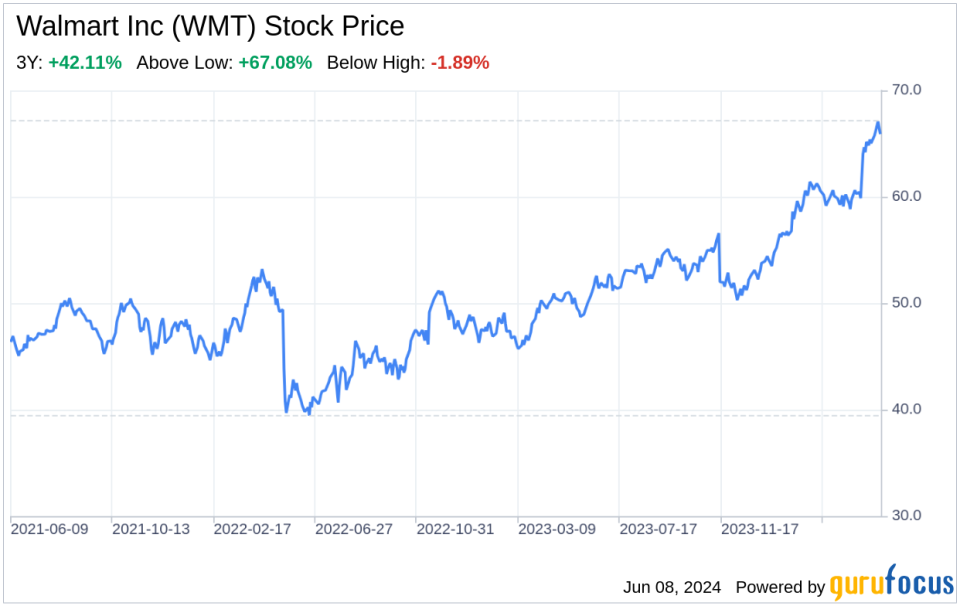Decoding Walmart Inc (WMT): A Strategic SWOT Insight
Walmart Inc (NYSE:WMT) showcases robust revenue growth and significant net income increase in Q1 2024.
Strategic omni-channel initiatives and eCommerce growth bolster Walmart's market position.
Legal and regulatory challenges persist, posing potential risks to Walmart's operations.
Walmart's aggressive pricing strategies in response to inflation reflect a strong customer focus.
On June 7, 2024, Walmart Inc (NYSE:WMT) filed its 10-Q report, revealing a financial snapshot of the company's performance in the first quarter of fiscal year 2025. The retail giant reported a notable increase in net sales, climbing to $159.9 billion from $151 billion in the previous year. Membership and other income also saw an uptick, contributing to total revenues of $161.5 billion, up from $152.3 billion. Operating income rose to $6.8 billion, a significant improvement from $6.2 billion in the prior year. Net income attributable to Walmart surged to $5.1 billion, a substantial increase from $1.7 billion, reflecting the company's operational efficiency and strategic initiatives. These figures underscore Walmart's financial resilience and its ability to navigate a complex retail landscape.

Strengths
Robust Financial Performance: Walmart's financial health is a testament to its operational efficiency and strategic initiatives. The Q1 2024 report indicates a solid increase in net sales and a remarkable jump in net income attributable to Walmart, from $1.7 billion in Q1 2023 to $5.1 billion in Q1 2024. This financial robustness provides Walmart with the capital necessary to invest in growth opportunities, technological advancements, and competitive pricing strategies, ensuring its continued dominance in the retail sector.
Omni-channel and eCommerce Expansion: Walmart's commitment to an omni-channel strategy has paid dividends, with eCommerce net sales contributing significantly to the company's growth. In Q1 2024, Walmart U.S.'s eCommerce net sales positively impacted comparable sales by approximately 2.9%, driven by store-fulfilled pickup and delivery services. This focus on integrating physical and digital retail channels has enhanced customer convenience, expanded market reach, and fortified Walmart's position against pure-play online competitors.
Weaknesses
Legal and Regulatory Challenges: Walmart's operations are subject to a myriad of legal and regulatory pressures, as evidenced by ongoing litigation and investigations. These include antitrust matters, such as the case with COFECE in Mexico, and the Foreign Direct Investment matters in India with Flipkart. While Walmart is vigorously defending against these allegations, the outcomes are uncertain and could potentially lead to financial penalties or operational restrictions, impacting Walmart's international market presence and profitability.
Dependency on Physical Footprint: Despite strides in eCommerce, Walmart's business model remains heavily reliant on its vast network of physical stores. This dependency exposes the company to risks associated with real estate, such as the need for continual investment in store maintenance and upgrades, as well as vulnerability to shifts in consumer shopping behaviors favoring online channels. Balancing the costs and benefits of such a large physical presence is an ongoing challenge for Walmart.
Opportunities
Global Expansion: Walmart's international operations, which generated $115 billion in sales, present significant opportunities for growth. Markets such as India and China offer vast consumer bases and rising middle classes eager for Walmart's value proposition. By leveraging its global supply chain and adapting to local tastes and preferences, Walmart can further penetrate these markets and drive international revenue streams.
Technological Innovation: Investment in technology, such as automation and artificial intelligence, offers Walmart the opportunity to enhance operational efficiency and customer experience. Innovations in inventory management, personalized marketing, and streamlined logistics can lead to cost savings and improved service levels, reinforcing Walmart's competitive edge in a rapidly evolving retail landscape.
Threats
Intense Competition: Walmart operates in a highly competitive retail environment, facing pressure from both traditional brick-and-mortar retailers and eCommerce giants. Competitors are continually innovating and adapting their strategies to capture market share, necessitating constant vigilance and innovation from Walmart to maintain its leadership position.
Economic and Geopolitical Uncertainties: Walmart's global operations expose it to economic and geopolitical risks, including currency fluctuations, trade tensions, and regulatory changes. These factors can affect Walmart's cost structures, pricing strategies, and market access, requiring strategic agility and proactive risk management to mitigate potential adverse impacts.
In conclusion, Walmart Inc (NYSE:WMT) demonstrates a strong financial foundation, bolstered by its omni-channel initiatives and eCommerce growth. However, the company must navigate ongoing legal and regulatory challenges, as well as the complexities of a vast physical store network. Opportunities for global expansion and technological innovation present pathways for continued success, but Walmart must remain vigilant against intense competition and the uncertainties of the global economic and geopolitical landscape. By leveraging its strengths and addressing its weaknesses, while capitalizing on opportunities and mitigating threats, Walmart is well-positioned to sustain its market leadership and drive shareholder value.
This article, generated by GuruFocus, is designed to provide general insights and is not tailored financial advice. Our commentary is rooted in historical data and analyst projections, utilizing an impartial methodology, and is not intended to serve as specific investment guidance. It does not formulate a recommendation to purchase or divest any stock and does not consider individual investment objectives or financial circumstances. Our objective is to deliver long-term, fundamental data-driven analysis. Be aware that our analysis might not incorporate the most recent, price-sensitive company announcements or qualitative information. GuruFocus holds no position in the stocks mentioned herein.
This article first appeared on GuruFocus.

 Yahoo Finance
Yahoo Finance 